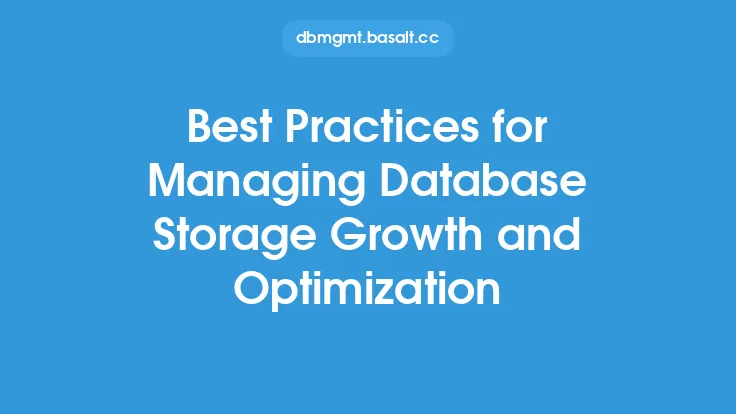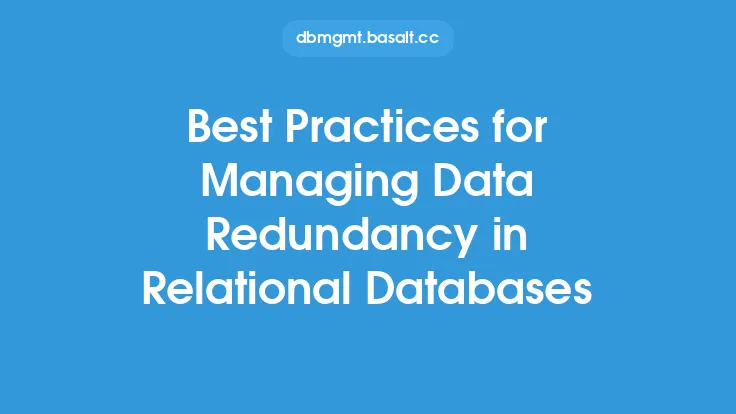When it comes to managing large amounts of data, data warehousing is a crucial aspect of any organization's data management strategy. A data warehouse is a centralized repository that stores data from various sources in a single location, making it easier to access and analyze. However, with the increasing amount of data being generated every day, it's essential to follow best practices for efficient data storage in a data warehouse. In this article, we'll discuss the key best practices for data warehousing that can help organizations optimize their data storage and retrieval processes.
Introduction to Data Warehousing Best Practices
Data warehousing best practices are guidelines that help organizations design, implement, and manage their data warehouses effectively. These best practices cover various aspects of data warehousing, including data modeling, data integration, data storage, and data retrieval. By following these best practices, organizations can ensure that their data warehouse is scalable, flexible, and able to meet the changing needs of their business.
Data Modeling Best Practices
Data modeling is a critical aspect of data warehousing, as it determines how data is organized and stored in the warehouse. Here are some data modeling best practices to follow:
- Use a star or snowflake schema to simplify data querying and improve performance
- Use surrogate keys to uniquely identify each record and improve data integrity
- Use data normalization techniques to minimize data redundancy and improve data scalability
- Use data denormalization techniques to improve data query performance and reduce data complexity
- Use data warehousing tools and software to automate data modeling and improve data consistency
Data Integration Best Practices
Data integration is the process of combining data from multiple sources into a single, unified view. Here are some data integration best practices to follow:
- Use data integration tools and software to automate data integration and improve data consistency
- Use data quality checks to ensure that data is accurate, complete, and consistent
- Use data transformation techniques to convert data into a standardized format
- Use data mapping techniques to map data from source systems to the data warehouse
- Use data validation techniques to ensure that data is valid and consistent
Data Storage Best Practices
Data storage is a critical aspect of data warehousing, as it determines how data is stored and retrieved. Here are some data storage best practices to follow:
- Use a scalable and flexible data storage architecture to accommodate growing data volumes
- Use data compression techniques to reduce data storage costs and improve data retrieval performance
- Use data encryption techniques to ensure that data is secure and protected
- Use data backup and recovery techniques to ensure that data is safe and can be recovered in case of a disaster
- Use data archiving techniques to store historical data and improve data retrieval performance
Data Retrieval Best Practices
Data retrieval is the process of accessing and retrieving data from the data warehouse. Here are some data retrieval best practices to follow:
- Use optimized data retrieval techniques to improve data query performance and reduce data latency
- Use data caching techniques to store frequently accessed data and improve data retrieval performance
- Use data indexing techniques to improve data query performance and reduce data latency
- Use data partitioning techniques to divide large datasets into smaller, more manageable pieces
- Use data aggregation techniques to summarize large datasets and improve data retrieval performance
Data Governance Best Practices
Data governance is the process of managing and overseeing data across the organization. Here are some data governance best practices to follow:
- Establish a data governance framework to define data policies, procedures, and standards
- Establish a data governance team to oversee data management and ensure data quality
- Use data quality metrics to measure data accuracy, completeness, and consistency
- Use data security measures to ensure that data is secure and protected
- Use data compliance measures to ensure that data is compliant with regulatory requirements
Conclusion
In conclusion, data warehousing best practices are essential for efficient data storage and retrieval. By following these best practices, organizations can ensure that their data warehouse is scalable, flexible, and able to meet the changing needs of their business. Remember to use data modeling, data integration, data storage, data retrieval, and data governance best practices to optimize your data warehouse and improve data insights. With the right data warehousing strategy, organizations can unlock the full potential of their data and make informed business decisions.





